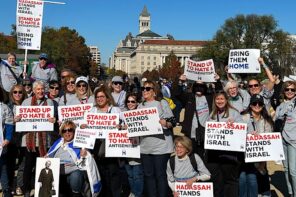Though Wheaton professor Larycia Hawkins was officially reprimanded for claiming that Muslims and Christian worship the same god, it was Hawkins’ decision to wear a hijab that has inspired women and girls from many backgrounds to follow suit in solidarity with Muslims facing hostility. In response, journalists Asra Nomani and Hala Arafa took it upon themselves to ask non-Muslim women to please stop. In their words, the ‘spectacle’ of such solidarity campaigns are “a painful reminder of the well-financed effort by conservative Muslims to dominate modern Muslim societies.”
Feminism is at its best, most productive, most socially-conscious when it incorporates Crenshaw’s understanding of intersectionality; without a deeply nuanced understanding of race, religion, sexuality, and able-bodied-ness coupled with discussions on gender, we run the risk of reproducing the narrow, uncritical discussions of earlier feminist debates. And that’s exactly where, I argue, the online Muslim community has been stuck over the last few days.
Can we just stop for a minute?
While I can agree with Nomani and Arafa’s critique of Wahhabi, Saudi-funded Islamist groups that support more conservative and often sexist ideologies and policies across the Muslim world, I’m hesitant to rope the hijab into this socio-political and economic constellation of issues.
The arc of their argument goes something like this: non-Muslim Americans should not show solidarity with Muslims by wearing the hijab since the hijab is a painful reminder of Islamist, extremist religious campaigns and supports a religious ideology of women as subordinate to men; a short exegesis, which shows how Quran doesn’t support the hijab, is followed by the claim that in the 20th century the hijab has been imposed on Muslim women to subjugate them. Thus, they conclude, please don’t wear it and join our movement instead.
Nowhere in this diatribe do the writers explain that the solidarity campaigns have been in response to the series of incidents involving anti-Muslim hate crimes and Islamophobic rhetoric that has placed Muslims (and non-Muslims like Sikhs) in a highly vulnerable and stressful position. Of the many forms of harassment faced by Muslims in America today, harassment around the hijab has become central. The bigots and racists see a hijab and feel compelled to ascribe a terrorist identity to hijab and attack these women.
This is even happening in middle schools, as in the case of a 6th grade student in the Bronx who had her hijab forcibly pulled off by classmates. Women in hijab speak of walking in their city and being called ISIS and harassed. The very real violence and abuse occurring in America and around the world against Muslim hijabi women is not discussed anywhere in their article. For writers so concerned about context around a particular practice, this lack of contextual specificity for why ‘wear-a-hijab’ has become national news is conspicuous.
Instead they choose to frame their argument around a pseudo-feminist critique of the hijab as a stand-in for ‘conservative Muslim patriarchy.’ This rhetorical maneuver disempowers the thousands of women who have decided to wear the hijab and paints them as subjugated women in need of a savior. In her famous essay “Can the Subaltern Speak?,” noted postcolonial feminist Gayatri Spivak explains that white men are interested in saving brown women from brown men. In the current case, however, rather than white men, it’s middle-class, brown women professionals who have come to liberate the hijabis. This brand of feminism presents itself as a form of benevolence but much more closely resembles neocolonial forms of violence.
As a researcher who works with young Muslim women in New York City, some who wear the hijab and some who do not, it makes me squirm to hear the echo of arguments that surfaced in 2001: that the US must continue the war on terror in order to liberate and save Afghan women. But in the case of Nomani and Arafa, it is no longer as simple as a white imperialist nation seeking to rescue the brown, Muslim people from themselves.
Here, two Muslim women rely on their authenticity as Muslim women to speak on behalf of other Muslim women—a right, I’d argue, they do not have—to ask that no one wear hijab in solidiarity, because the hijab itself is a problem. Their stance is particularly problematic when we consider their absurd connection between all hijab and conservative, sexist Muslim patriarchal cultural practices. To strip hijabi women of their agency is a powerfully dangerous move that should be identified as such.
Recently, I had a short chat with one of my research participants, a Muslim college student in New York City. When we first met, “Sarah” (not her real name) did not wear the hijab. She was a prominent member of her college’s Muslim Student Association when she wasn’t hanging out with friends in the city or watching Bollywood movies at home. Sarah decided to wear the hijab earlier this year because, she told me, it changed the way she socialized with others. Being publicly seen as a Muslim gave her more time to reflect in the moment, to be more mindful of her words and actions, to be nicer to “random people” as she put it.
Materially, the hijab is but a piece of cloth. As a social object, it is given value by its wearer and the audience. As an anthropologist, I am careful not to get caught up in the ‘true’ meaning of hijab and what religious meaning it has been given by Islamic scholars and non-scholars. Rather, I believe we should concern ourselves primarily with the value given to it by the wearer.
Personally I do not wear the hijab, but I respect the women who choose to for whatever reason, the same way I would respect any other spiritual act a person chooses to practice, so long as it doesn’t cause harm. As a Muslim woman, I’ve appreciated the outpouring of support and solidarity amidst a toxic Islamophobic discourse, and look forward to being a part of these campaigns in the future.





